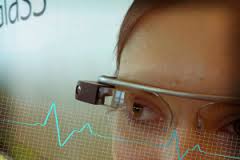 If and when Google Glass becomes available to the general public sometime in 2014, there is reason to believe it could impact our health care delivery system. Will it be as impactful as smartphones and tablets? The jury is still out on that. Much of that depends on its becoming as ubiquitous as those other devices, and in getting the price down from its current $1500. Glass looks like ordinary eyeglasses with a smartphone-like display lens. It is hands-free voice command or touch pad controlled, with Bluetooth/WiFi connectivity and IOS/Android compatible. Sound uses bone conduction that only the wearer hears and it has a motion accelerator for gestural commands.
If and when Google Glass becomes available to the general public sometime in 2014, there is reason to believe it could impact our health care delivery system. Will it be as impactful as smartphones and tablets? The jury is still out on that. Much of that depends on its becoming as ubiquitous as those other devices, and in getting the price down from its current $1500. Glass looks like ordinary eyeglasses with a smartphone-like display lens. It is hands-free voice command or touch pad controlled, with Bluetooth/WiFi connectivity and IOS/Android compatible. Sound uses bone conduction that only the wearer hears and it has a motion accelerator for gestural commands.
For those “bold, creative persons” test driving the first generation, the consensus was that this device was especially applicable to medicine. “Glass Explorers”, as Google calls testers, have used the device in a variety of medical/therapeutic settings: from manifestations of autism, to music therapy sessions, to teaching proper bedside
manner. For physical therapists, Glass can be used to video therapy sessions,retrieve previous videos and then overlay those onto a current session to evaluate patient progress. Being able to visually compare a patient’s ROM over time, alerts the therapist to any significant changes that would require adjustments to the treatment plan. If Glass can be enabled to not only track but also measure ROM hands-free, it could prove to be an invaluable asset in the PT’s toolbox.
What other uses do you see for Glass in your PT practice? Comment on our Facebook page. Looking for a work environment that incorporates innovation and progressive techniques call a company that uses cutting edge technologies to achieve your goal…call the Centra Team at 800 535 0076.